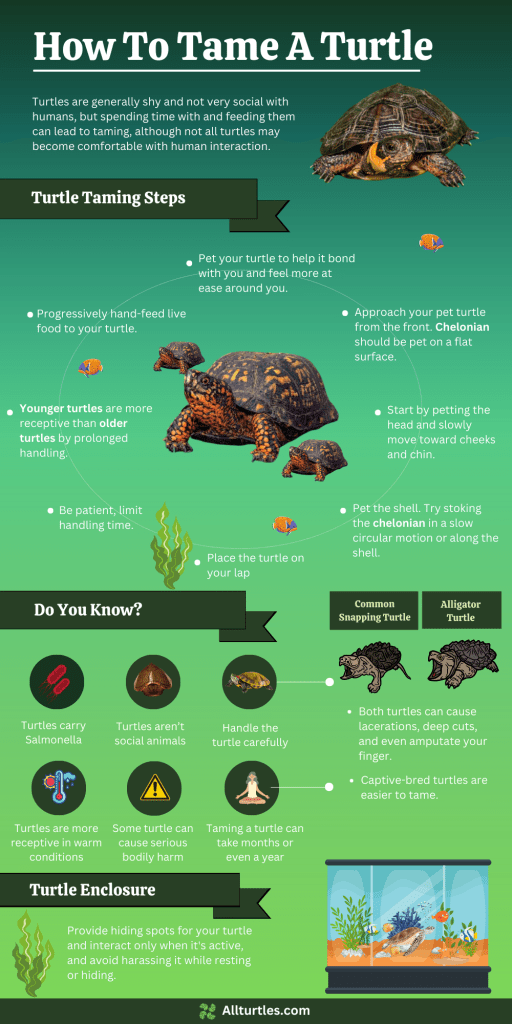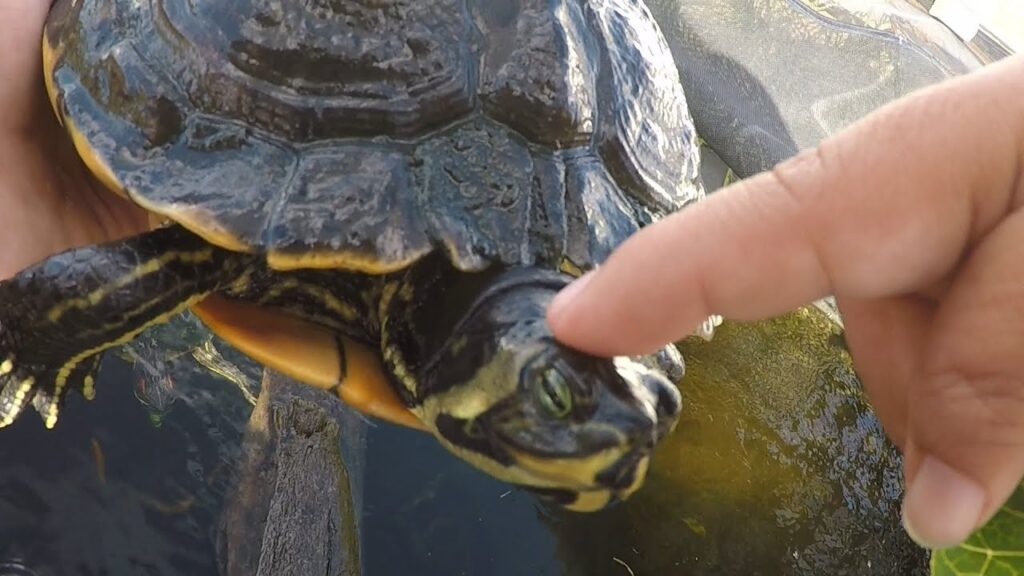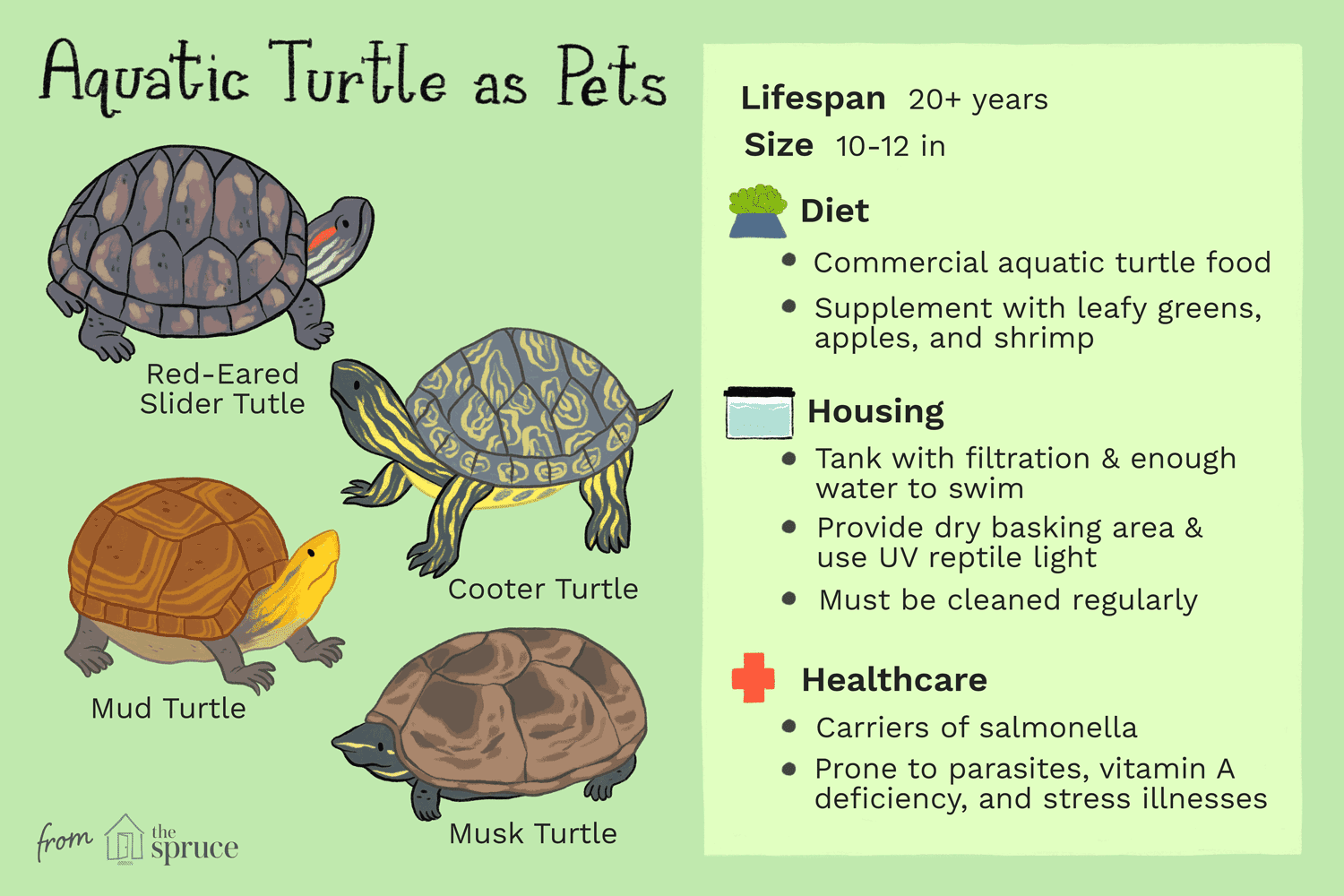So, you’ve brought home a new pet turtle and you’re excited to start forming a bond with them. Whether you’re a first-time turtle owner or have had experience with these reptilian companions before, it’s important to understand how to properly tame and bond with your turtle. In this article, we will provide you with practical tips and advice on how to create a trusting relationship with your pet turtle, ensuring a happy and fulfilling companionship for both of you. From creating a comfortable habitat to establishing a routine of interaction, we’ll cover all the essential steps to help you establish a strong bond with your aquatic friend.
Choosing the Right Turtle
When it comes to choosing a turtle as a pet, there are a few factors you’ll want to consider to ensure you find the right species for you. First and foremost, you’ll want to do some research on different turtle species. Each species has its own unique needs and characteristics, so it’s important to choose one that aligns with your lifestyle and experience level as a pet owner.
Another important aspect to consider is the size and lifespan of the turtle. Some turtles can grow quite large, so you’ll need to make sure you have enough space to accommodate their size. Additionally, turtles can live for many years, with some species living for several decades. Make sure you are prepared to commit to the long-term care and responsibility that comes with owning a pet turtle.
Lastly, evaluate the level of care required for each species you are considering. Some turtles may require more specialized care and attention than others. Consider factors such as dietary needs, habitat requirements, and any specific medical needs the turtle may have. It’s essential to choose a turtle that you feel confident and capable of providing the necessary care for.
Setting Up the Perfect Habitat
Once you’ve chosen the right turtle for you, it’s essential to create a habitat that meets their needs and promotes their overall well-being. Selecting an appropriate terrarium is crucial for providing a safe and comfortable living space for your turtle. It should be large enough for the turtle to move around and have ample room for basking and swimming.
Temperature and lighting are two critical elements to consider when setting up your turtle’s habitat. Turtles are ectothermic, meaning they rely on external heat sources to regulate their body temperature. Ensure you provide a basking area with a heat lamp to maintain the necessary warmth. Additionally, UVB lighting is crucial for the synthesis of vitamin D3, which is essential for healthy shell growth and overall well-being.
Proper filtration and water quality are also crucial for maintaining a healthy habitat for your turtle. Invest in a good quality filtration system that can adequately remove waste and impurities from the water. Regularly monitor and maintain the water parameters to ensure optimal cleanliness and prevent the buildup of harmful bacteria.

Establishing a Routine
Establishing a routine is essential for the overall well-being and health of your turtle. Consistent feeding times should be maintained to ensure your turtle receives the necessary nutrition. Research the specific dietary needs of your turtle’s species and provide a balanced diet accordingly. It’s important not to overfeed your turtle to avoid nutritional imbalances and obesity.
In addition to feeding, establishing a daily care schedule is crucial. This includes tasks such as checking the temperature and humidity levels in the terrarium, cleaning the habitat, and providing fresh water daily. By maintaining a consistent schedule, you’ll ensure that your turtle’s needs are consistently met.
Regular health checks are also an essential part of your routine. Keep an eye out for any changes in your turtle’s behavior, appetite, or physical appearance. If you notice anything out of the ordinary, it’s important to consult with a reptile veterinarian for proper diagnosis and treatment.
Building Trust with Your Turtle
Building a bond of trust with your turtle is a rewarding and important part of pet ownership. Approaching your turtle slowly and calmly is crucial to not startle or stress them. Sudden movements or loud noises can be frightening for turtles, so it’s important to create a calm and peaceful environment for interactions.
Using gentle touch and handling techniques is also crucial for building trust with your turtle. Turtles have sensitive skin, so it’s important to handle them with care. Support their shell properly and avoid applying too much pressure. Slowly stroke their skin to help them become comfortable with your touch. However, be cautious with sensitive areas such as their eyes, ears, and tail, as these can be easily injured or irritated.
Offering favorite treats as rewards can also help build a positive association with you. Turtles have individual preferences, so try out different treats to see what your turtle enjoys. Treats such as mealworms, strawberries, or leafy greens can be used as a special reward during training sessions or to encourage social interaction.

Creating a Safe and Enriching Environment
Creating a safe and enriching environment is essential for the overall well-being and happiness of your pet turtle. Adding hiding spots and basking areas to the terrarium allows your turtle to feel secure and comfortable. These can be achieved by placing rocks, logs, or artificial hides strategically within the habitat.
Incorporating toys and enrichment activities is another great way to keep your turtle mentally stimulated and entertained. Floating toys, such as ping pong balls or floating plants, can encourage your turtle to engage in play and exploration. Additionally, rearranging the habitat and introducing new objects from time to time can create novelty and prevent boredom.
It’s also important to avoid exposing your turtle to harmful substances. Avoid using any chemicals or cleaning products near the terrarium that could potentially harm your turtle. Also, be cautious with any plants or decorations you introduce to the habitat, as some may be toxic to turtles. It’s important to research and choose safe options for your turtle’s environment.
Proper Feeding and Nutrition
Understanding your turtle’s dietary needs is crucial for their overall health and happiness. Different turtle species have different dietary requirements, so it’s important to research and provide the appropriate food options for your turtle. Some turtles are herbivores, while others are omnivores or carnivores. Ensure you are meeting their specific nutritional needs.
Offering a variety of food options is important to ensure a balanced diet. Commercial turtle pellets can be a staple food source, but it’s important to supplement with fresh vegetables, fruits, and proteins. Leafy greens, carrots, strawberries, and insects such as mealworms or crickets can all be included in your turtle’s diet. It’s essential to provide a mix of different food items to prevent nutritional imbalances.
Avoid overfeeding your turtle, as this can lead to obesity and health issues. Turtles have a slower metabolism compared to other pets, so it’s important not to overindulge them. Monitor their weight and adjust the portion sizes accordingly. If you’re unsure about the appropriate portion sizes, consult with a reptile veterinarian for guidance.

Handling and Touching Techniques
Proper handling and touching techniques are crucial for both your turtle’s safety and your own. When handling your turtle, it’s important to support their shell properly. Place one hand on each side of the shell, avoiding excessive pressure on the top or bottom. This ensures that the turtle’s weight is distributed evenly and prevents any strain on their shell or internal organs.
Stroking and touching your turtle’s skin can help with bonding and comfort. Gently stroke their head, neck, and limbs, especially in areas where your turtle enjoys being touched. However, be cautious around more sensitive areas, such as their eyes or ears. Refrain from touching or handling these areas unless it’s necessary for their health and well-being.
Using caution with sensitive areas is crucial to prevent any discomfort or injury to your turtle. If you need to clean around their eyes or nostrils, use a soft, damp cloth or cotton swab. Always be gentle and avoid any rough handling that could cause stress or harm to your turtle.
Recognizing Signs of Stress or Illness
As a responsible turtle owner, it’s important to be vigilant and observant of any signs of stress or illness in your pet. Changes in behavior or appetite can indicate that something is wrong. If you notice your turtle becoming more withdrawn, aggressive, or uninterested in food, it may be a sign of stress or illness. Conversely, an increase in hiding or lethargy can also be cause for concern.
Monitoring your turtle’s physical appearance and activity levels is also crucial. Any changes in their skin or shell, such as discoloration, lesions, or abnormalities, should be thoroughly examined. Additionally, changes in their swimming or basking patterns can be indicative of an underlying health issue.
If you notice any concerning signs or have any doubts about your turtle’s well-being, it’s important to consult with a reptile veterinarian. They can provide expert advice and guidance on diagnosing and treating any potential health issues or concerns.

Maintaining Cleanliness and Hygiene
Maintaining cleanliness and hygiene in your turtle’s habitat is essential for their health and well-being. Regularly cleaning the terrarium is necessary to prevent the buildup of waste and bacteria. Remove any uneaten food, feces, or debris from the terrarium on a daily basis. Additionally, perform a deep cleaning of the entire habitat at least once a month, removing and cleaning all decor, rocks, and substrate.
Monitoring water quality and pH levels is also important for maintaining a clean and healthy habitat. Turtles produce a significant amount of waste, so it’s essential to use a good quality filtration system to keep the water clean and clear. Regularly test the water parameters, such as pH levels and ammonia levels, and take appropriate actions to maintain optimal conditions.
Preventing the spread of harmful bacteria is also crucial. Wash your hands thoroughly before and after handling your turtle or working in their habitat. Avoid introducing any contaminants or harmful substances into the terrarium. Regularly disinfect any equipment or tools used in the habitat to ensure they are clean and bacteria-free.
Respecting Your Turtle’s Boundaries
Respecting your turtle’s boundaries is essential for their overall well-being and happiness. Turtles need their privacy and rest, so it’s important to provide them with designated areas where they can retreat and feel secure. Hiding spots and basking areas are crucial for creating these spaces within the terrarium.
Recognizing signs of discomfort or stress is also important. Turtles have their own unique personalities and tolerances for social interaction. If your turtle shows signs of distress, such as excessively retreating or becoming aggressive, it’s important to back off and give them some space. Respect their boundaries and allow them to dictate the level of social interaction they are comfortable with.
Avoid overstimulation or aggressive behavior when interacting with your turtle. Turtles are not naturally inclined to seek out physical touch or play, so it’s important to be mindful of their individual preferences and comfort levels. By respecting their boundaries, you’ll establish a trusting and respectful relationship with your turtle.
In conclusion, taming and bonding with your pet turtle requires patience, consistency, and a deep understanding of their unique needs and behaviors. By choosing the right turtle species, providing a suitable habitat, establishing a routine, building trust, creating a safe environment, ensuring proper feeding and nutrition, practicing gentle handling, recognizing signs of stress or illness, maintaining cleanliness and hygiene, and respecting your turtle’s boundaries, you can foster a strong and mutually beneficial bond with your beloved turtle.

